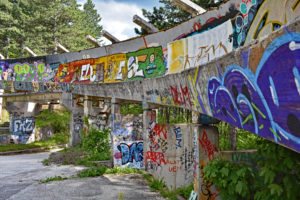Sarajevo is not a large city and we found it easy to navigate our way around. Many of the roads had large green signs bearing the road name and underneath a little history, both in Bosnian and English, and a QR code for more information.
ARCHDUKE FRANZ FERDINAND
As well as the Siege of Sarajevo, during the Bosnian War, the capital is also known for the assassination of Archduke Franz Ferdinand, which led to the start of World War 1.
An information board marked the riverside spot where the event took place and opposite was a small museum. The window displayed grainy black and white photographs including one of the assassins. Although we were told that Gavrilo Princip who actually fired the shots, was the only one too young to execute, I’ve since read differing stories. However, he died in a jail relatively young – killed by water torture or tuberculosis.
Inside the small single room was a brilliant short video of the assassination which intercut black and white archive footage with a coloured reconstruction. There was lots of WW1 memorabilia including medals, uniforms, photographs with explanations in English and a map showing the seven protagonists and their location. It was amazing that having survived a failed attempt on his life earlier in the day, when the Archduke survived by lobbing the grenade out of the car, the visit continued.
WINTER OLYMPICS
The Winter Olympics of 1984 were held in Sarajevo and was of course where Torvill and Dean won their Gold Medal. The symbol of the Olympics, a snowflake, was still imprinted in many of the pavements. We took a Ski lift to Trebević and saw how the size of the original cable car cabins, varied from today’s monsters. We had good views over the city and a café was being built. Just out of town, we visited the bob sleigh run, now a tourist landmark but more for the graffiti covering it.
Our guide took us to his favourite Ice cream shop (Egipat). The owners were originally from Macedonia and during the winter Olympics, the Italians loved the ice cream so much, they wanted to buy the recipe. The ice cream which comes only in three flavours – vanilla, chocolate and hazelnut – was delicious and inside we saw the display of cakes divided into two: chocolate cakes and gateaux, a legacy of the Austro-Hungarian and Ottoman inspired baklavas.
ARCHITECTURE AND SHOPPING
Wherever you look, the architecture is different and reflects so many facets of Sarajevo: its Ottoman, Austro-Hungarian or socialist era histories, whether it was affected by the Bosnian War and if so, how it was rebuilt.
Off the main square were a number of pedestrianised streets lined with bars, cafés, restaurants and shops. When trade developed in the mid-15th century, each street would have had its trade be it silk tailors or book binders. Whilst this is still seen today, it has now a modern twist: Saraci Street which would have sold leather saddles now sells leather handbags and a street full of goldsmiths, now concentrates on trinkets. We saw souvenirs pens made from bullets and copper Bosnian coffee pots on trays with cups made from shell cases were ubiquitous.
There are many facets to Sarajevo and, although we only touched on some of them during our four-night stay, we certainly felt more well informed on leaving.















